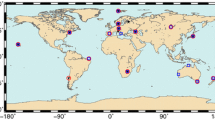Abstract
The GEOSAT software for satellite geodetic and geodynamics applications has lately been extended to Very Long Baseline Interferometry (VLBI) applications. Geodetic VLBI data have been analyzed using this software and station coordinates and velocities, source coordinates, and earth orientation parameters have been derived in a global mode using data from the Extended Research and Development Experiment (ERDE) and the Research and Development series (R&D) within the NASA's CDP.
It is demonstrated using the ERDE data, that the program is capable of calculating station coordinates with an accuracy of a few mm in the local horizontal plane and about 7 mm in the vertical direction. Analysis of the R&D dataset yields errors 2 to 3 times higher in all directions.
Similar content being viewed by others
8 References
[A] Proceedings of the AGU Chapman Conference on Geodetic VLBI: Monitoring Global Change, NOAA Technical Report NOS 137 NGS 49, 1991, U.S. Department of Commerce, National Oceanic and Atmospheric Administration, National Ocean Service.
Aksnes K, P H Andersen, and E Haugen (1988). A precise multipass method for satellite doppler positioning. Celest. Mech., Vol. 44, pp. 317–388.
Aksnes K., P. H. Andersen, S. Hauge, and H. Erlandsen (1993). ERS-1 Orbit Calculation with the GEOSAT Software, to be published in the proceedings of the 2nd ERS-1 symposium in Hamburg, Oct 11–14, 1993.
Andersen P H (1986). GEOSAT — a computer program for precise reduction and simulation of satellite tracking data. In proc. of the Fourth Int. Geod. Symp. on Satellite Geodesy, Austin, Texas, April 28 – May 2.
Andersen, P. H., S. Hauge and O. Kristiansen (1993). GPS relative positioning at the level of one part per billion. Bulletin Geodesique, 1993, Vol 67, No. 1, pp. 91–106.
Andersen, P. H. (1994). Unpublished.
Argus D F and R G Gordon (1991). No-net rotation model of current plate velocities incorporating plate motion model NUVEL1, Geophys. Res. Let., Vol. 18, No. 11, pp. 2039–2042.
Chao C C (1974). The Tropospheric Calibration Model for Mariner Mars 1971, JPL Technical Report 32-1587.
Corey B E and T A Clark (1991). The RF Bandwidth Upgrade: Doubling the X-Band Spanned Bandwidth of Geodetic VLBI Receiving Systems [in A].
Davis J L et al. (1985). Geodesy by radio interferometry: Effects of atmospheric modeling errors on estimates of baseline length, Radio Science, 20(6), 1593–1607.
Fallon F W and W H Dillinger (1992). Crustal Velocities From Geodetic Very Long Baseline Interferometry, Journ. of Geoph. Res., Vol.97, No.B5, 7129–7136, May 10.
Herring T., J. L. Davis, I. I. Shapiro (1990). Geodesy by Radio Interferometry: The Application of Kalman Filtering to the Analysis of Very Long Baseline Interferometry data, Journ. of Geophys. Res., Vol.. 95, No. B8, pp. 12,561–12,581.
Herring T (1991). Unpublished.
IERS Annual Report (1992). Observatoire de Paris.
Jacobs C S Modeling Antenna Effects for Millimeter-Level VLBI [abstract in A].
Manabe S, Sato T, Sakai S and Yokoyama K. Atmospheric Loading Effect on VLBI Observations [in A].
Macmillan S and J R Ray. Current precision of VLBI vertical determination [in A].
McCarthy D D (1992). IERS Standards. IERS Technical note 13, Observatoire de Paris.
Pagiatakis S D (1992). Program LOADSDP for the calculation of ocean load effects. Manuscripta Geodaetica, 1992, Vol 17, Nr. 6, pp. 315–320.
Ray J R and Corey B E Current Precision of VLBI Multi-Band Delay Observables [in A].
Ryan J W, Ma C, and W E Himwich NASA Crustal Dynamics Project results: Sensitivity of Geodetic Results to Clock and Atmosphere Estimation Models [in A].
Ryan J W (1989) CALC-7 Release Document, NASA Goddard Space Flight Center, Greenbelt, MD. USA.
Saastamoinen J (1972). Atmospheric Correction for the troposphere and stratosphere in radio ranging of satellites, in The Use of Artificial Satellites for Geodesy, Geophys. Monogr. Ser., vol. 15, ed. by S. W. Henriksen et al., 247–251, AGU, Washington, D.C.
Scherneck H G (1991). A Parameterized Solid Earth Tide Model and Ocean Tide Loading Effects for Global Geodetic Baseline Measurements, Geophys. J. Int., 106, pp. 677–694.
Thomas J B (1980). An Analysis of Source Structure Effects in Radio Interferometry Measurements, JPL Publication 80-84, Jet Propulsion Laboratory, Pasadena, California.
Zhu S Y, C Reigber and F H Massmann (1991). Some improvements of the solid earth tide model, Man. Geod., Vol. 16, pp. 215–220.
Author information
Authors and Affiliations
Rights and permissions
About this article
Cite this article
Andersen, P.H., Rekkedal, S. VLBI data analysis with the GEOSAT software. Bulletin Géodésique 69, 125–134 (1995). https://doi.org/10.1007/BF00815481
Received:
Accepted:
Issue Date:
DOI: https://doi.org/10.1007/BF00815481




